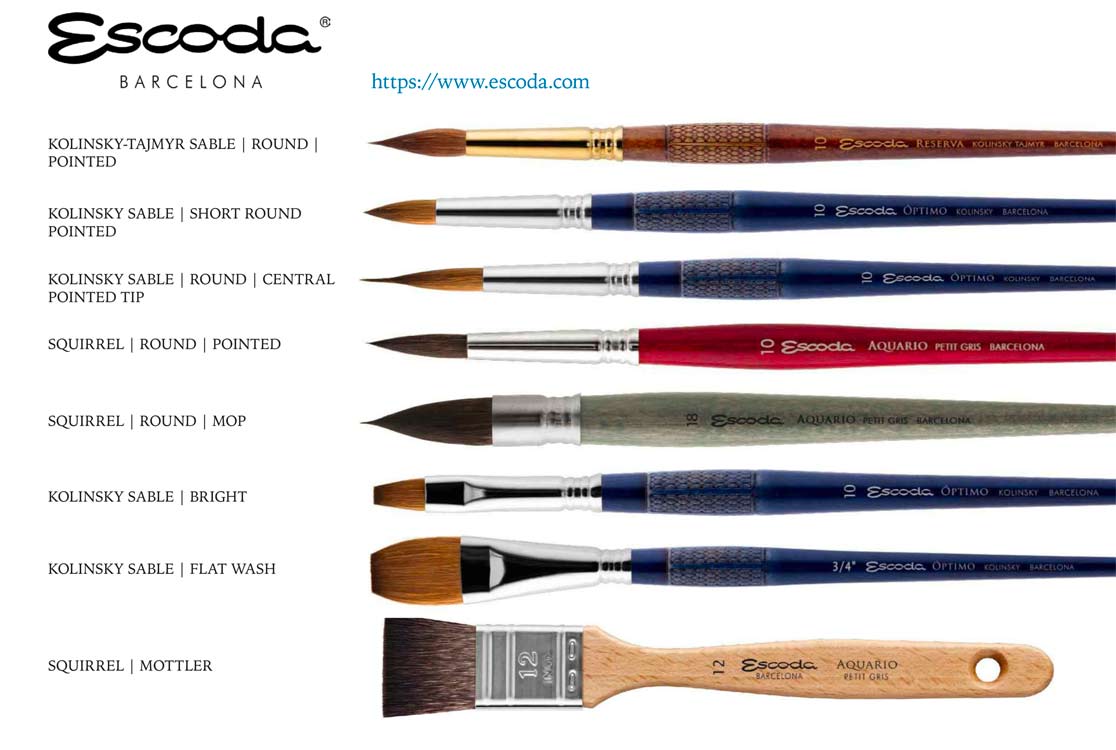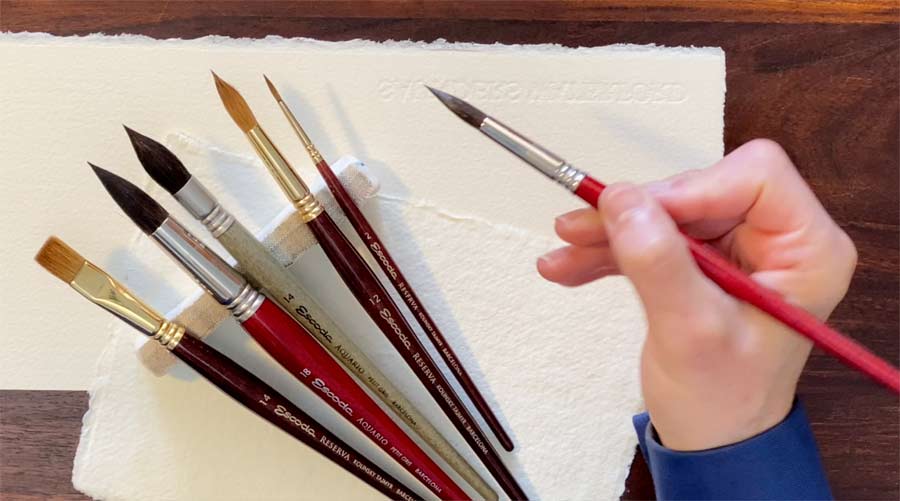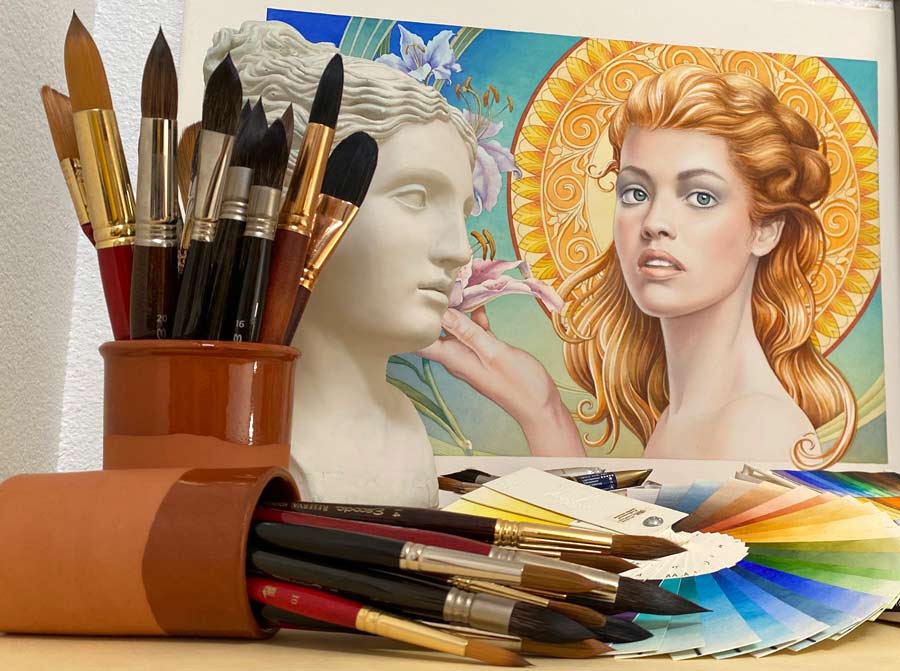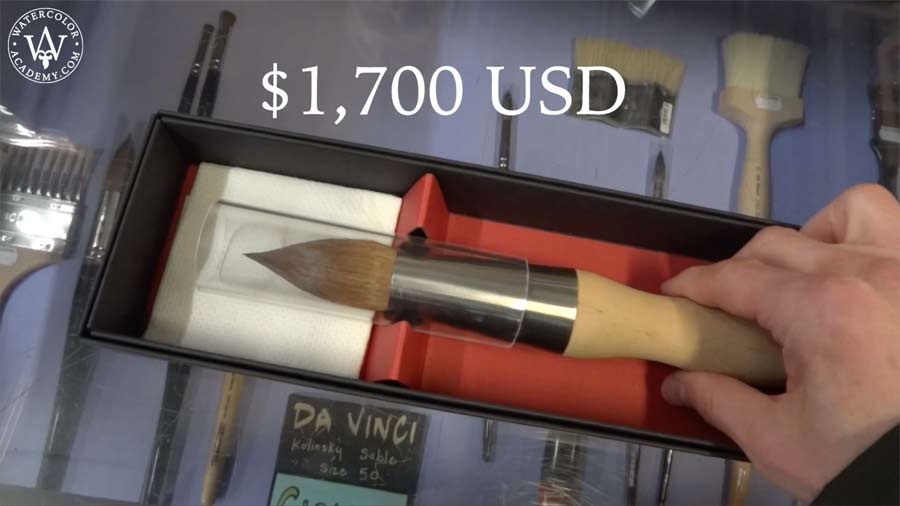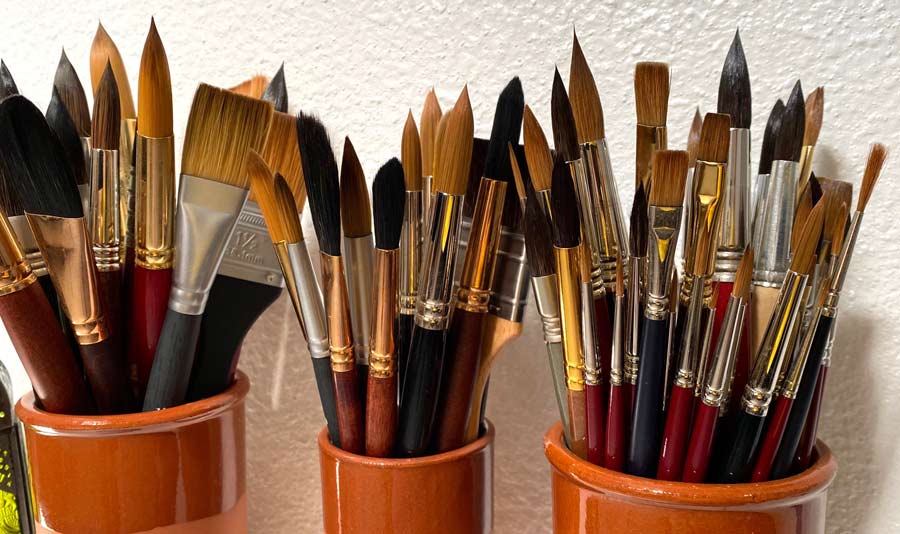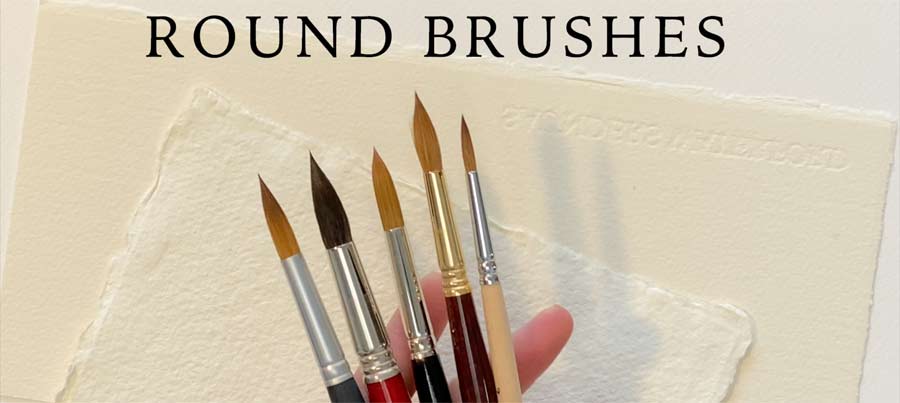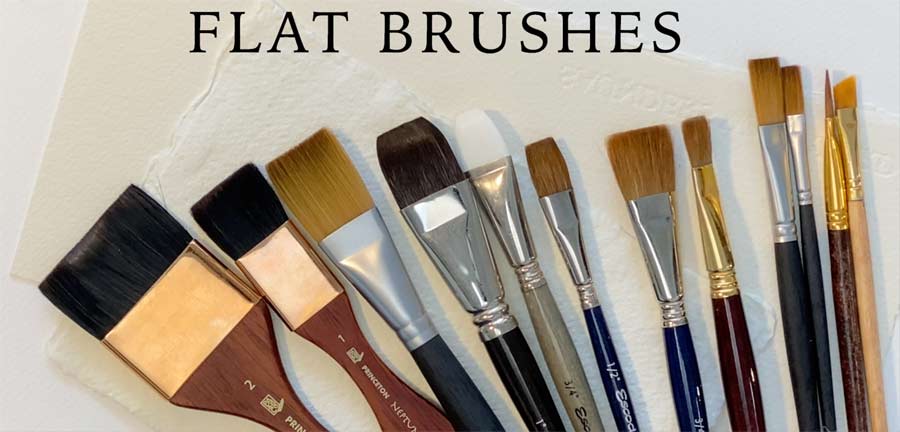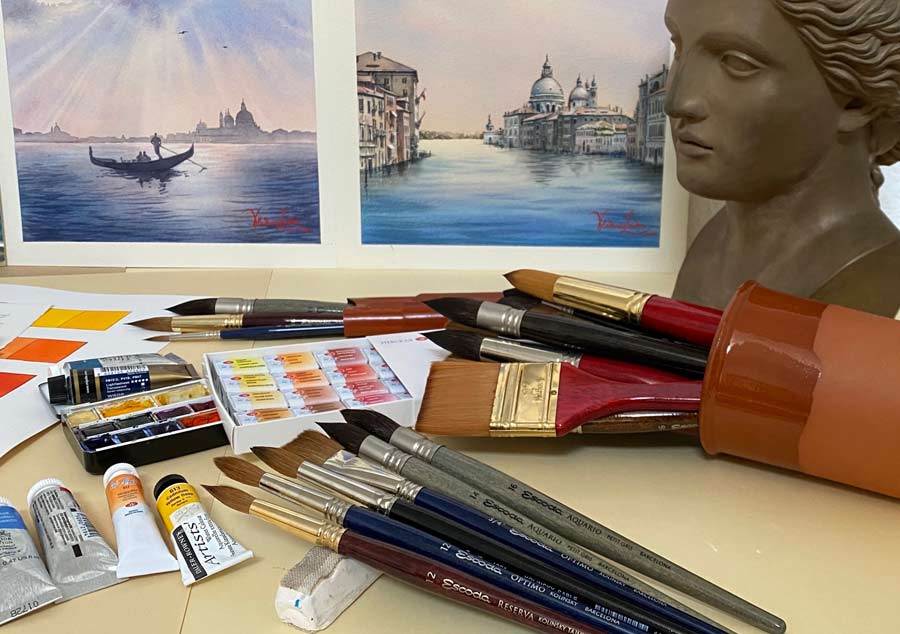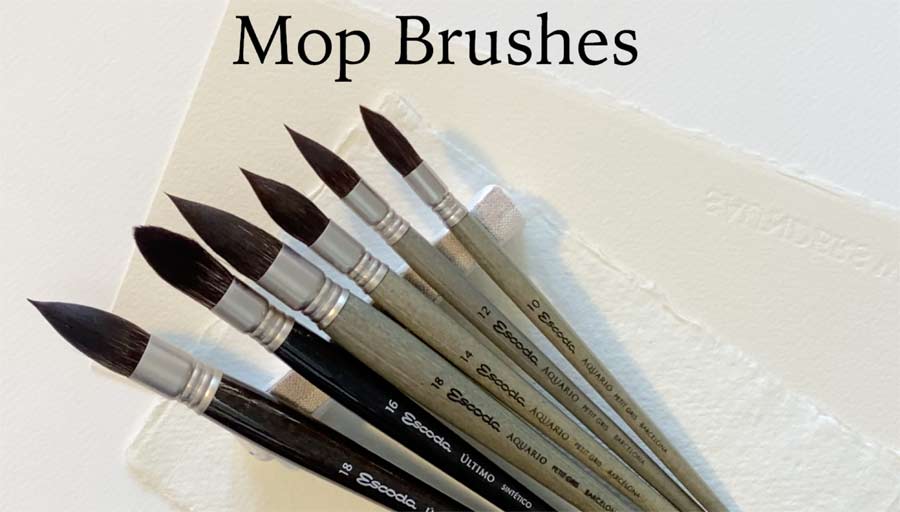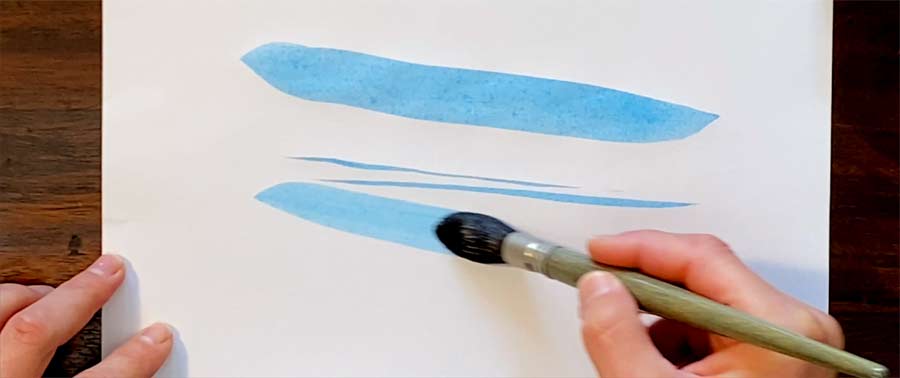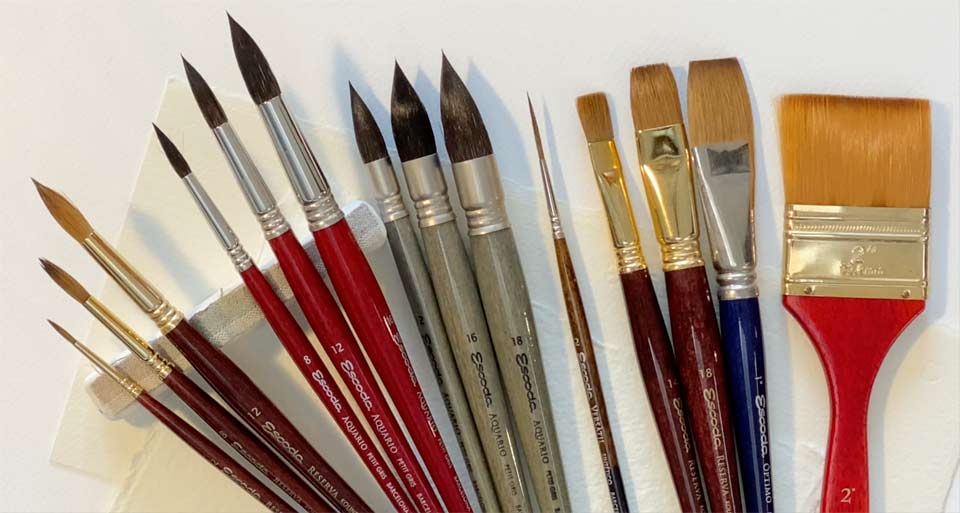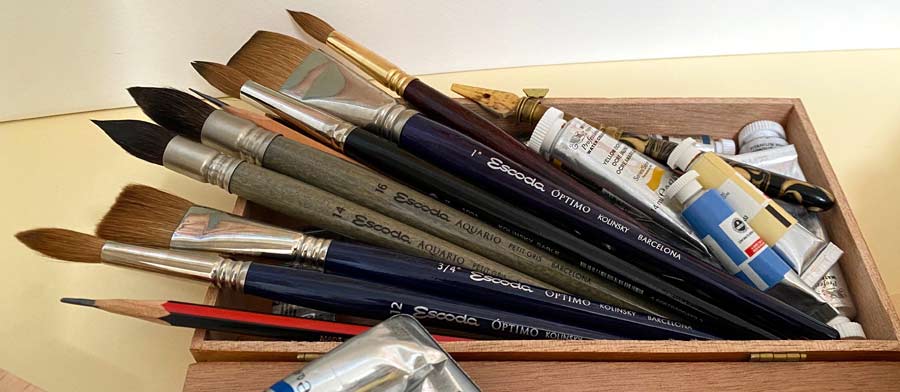Art Materials - Watercolor Brushes
Article by Vladimir London, Watercolor Academy tutor
After watercolor paper, the next most important element is watercolor brushes
Watercolor brushes have a simple structure – the tuft (hair or fiber), the handle and the ferule (the collar that connects the tuft and the handle). However, what a wide variety these three elements present! Brushes can have natural or synthetic tufts, come in various shapes and sizes, have different water-holding qualities and stiffness, different length and handle materials, different kinds of ferules, and all of these are multiplied by a large number of brush brands. This causes a lot of confusion for beginners, and some common mistakes and misconceptions. Here's what you need to be aware of:
- Good quality comes at a price.
- Not all expensive brushes are of premium quality.
- Not all natural brushes are good.
- Not all synthetic brushes are inferior.
- It is better to go for a bigger brush size than you think you need.
- The brush size numbers of different brands are not consistent.
- You don't need many brushes of different kinds.
- What brushes work for you will only become apparent with time.
I know that the statements above won't help you to make a purchasing decision so let's examine what watercolor brushes are made of, what shapes they can have, what qualities to look for, and how to test those qualities so you could make an educated choice when buying a watercolor brush.
A brush handle must feel comfortable in your hand.
Watercolor brush handles are generally shorter than those for oil or acrylic. They are usually made of hard wood, which is often lacquered or varnished. Synthetic handles are also available.
The ferule accounts for one-third of the cost of an average brush. It has to be seamless - an extruded cylinder, which is not rolled from a flat piece of metal - and made from copper alloys or plated to avoid corrosion. A good grip between the handle and the ferule is essential.
The most important part of the brush is clearly the tuft, which can be made of natural hair, synthetic fibers or a combination of both.
When it comes to natural hair you will often hear that kolinsky is the best brush money can buy. I have to say that the term "kolinsky" has been misused by manufacturers and no longer reflects the finest quality it used to be. Kolinsky is the name for a rare dark brown weasel with its natural habitat in Siberia whose tail contains strong, springy, well-shaped hairs. The truth is, the best hairs only come from the winter coat of the male that lives in the wild in the coldest and harshest areas of Siberia. This means manufacturers often use cheaper, less durable alternatives like the hair of the female of the species, and even other animals like mink, ermine, ferrets, and polecats which can be bred in captivity in warmer climates. All these alternatives are also called kolinsky for marketing purposes and to improve profit margins. So, a high price for a brush with the label, 'kolinsky' is not solid proof of the highest quality.
A genuine kolinsky sable comes from a variety of weasels called 'mustela sibirica', whose hairs have a very sharp point at the tip and are tapered at both ends, which gives a belly to the tuft and a point to the end. These brushes have a good capacity, natural spring, and are very durable and resilient. These qualities are unmatched by any other animal hairs. The rarity of kolinsky species, difficulty of trapping them, and the very high standards of the brush making demand high prices. I was looking at the Siberian Kolinsky brush size 50 in one of the art shops in London which had a price tag of over £1,200 ($1,700), wondering how it feels to paint with such a brush. Of course, I do not advocate going to such extremes. Smaller brushes come at cheaper prices and we will talk about the sizes you would need later.
A cheaper alternative to kolinsky is a natural red sable. Red sable hairs are slightly thinner, stiffer and shorter but almost as thirsty and resilient as kolinsky.
Another kind of natural hair you need to consider is squirrel. Squirrel brushes are very soft and thirsty; they can hold and release more water or paint than sable brushes and have very pointy tip when wet. Because squirrel hairs are soft, the brushes don't have the same spring as sables.
The best squirrel tufts are made of kazan brown squirrel hair. It is named after Kazan, a city in Russia which is in the region of its natural habitat. Black, gray and yellow hair come from other squirrel species but they are shorter and less resilient.
There are also cheaper brushes made of ox, mongoose, goat, pony and camel hair, as well as boar bristle available. I would not recommend any of these natural brushes as the main tool for watercolor painting.
If price, availability and a concern for the wild animals involved are an issue, you can consider synthetic brushes. The quality of some synthetic fibers come so close to natural hair today that you can buy a very good synthetic brush for a fraction of the price of its natural counterpart. I was testing Princeton brushes and was very impressed with the results. Some synthetic brushes are as thirsty as squirrel and as resilient and springy as sable and keep the pointy tip very well. In the Watercolor Academy videos, you can see different brushes in action in different watercolor painting lessons.
Now, let's examine brushes' shapes. Two of the most used shapes you will need are round and flat.
A round brush for watercolor must have a well-pointed tip when wet.
Brush sizes range from tiny at #00000 to big sizes like #20 and higher. The average brush size is about #12-14. Depending on the ratio of the wet tuft's length to the belly's diameter, round brushes can be divided into these subsets:
- Standard round (slightly more than four times ratio)
- Full bellied round (four times ratio with a fuller belly)
- Pointed round (five times ratio with a slim belly)
You will need to have several round brushes: both stiffer (sable or synthetic sable) and softer (squirrel or synthetic squirrel) hairs.
Flat brushes have a square or rectangular shape with a straight edge. They can be subdivided into:
- Bright (almost a square profile with the length of tuft equal to its width)
- Stroke (longer profile with the length almost twice the width)
- Chisel (a very short tuft)
There are also other specialty brushes with different shapes and sizes that are optional depending on your needs and painting style.
Mop brushes are round, made of soft hairs (usually squirrel), very thirsty, and have a pointy tip when wet. Mops are good for both thin and wide lines and washes. However, their softness can be limiting in some painting techniques where a stiffer brush is required.
Wash brushes – are wide and flat, ranging from 1" to 4", and ideal for wetting paper or applying wide washes over big areas. A good wash brush cannot only be used for wide brushstrokes, but also for very thin straight lines that are made by touching the paper's surface with the brush edge.
Filbert and Cat's Tongue are flat brushes with an oval edge, which when wet in the cat's tongue case end in a pointy tip. Such brushes have their place between round and flat and can produce both wide strokes and thinner lines.
Angle brushes (both flat and wash) are flat-shaped with an angular edge, which makes it easier to paint at an angle in comparison with straight-edged brushes.
Rigger brushes take their name from the historical application of painting nautical rigging lines. They are long, thin, round brushes with a very fine pointy tip. This is an ideal tool for painting long, thin lines.
Liner and Script brushes are similar to riggers but with a fuller belly. They are also good for painting long lines with thicker widths.
Dagger brushes are "knife" shaped with very pointy tip at one side of the edge. These brushes are good for making long lines which can vary from thin to much thicker strokes.
Detail brushes are small sized round brushes with a shorter tuft that is handy for painting small details.
Spotter brushes have very short round tuft which is good for stippling (painting in small dots).
Fan brushes are, as their name suggests, fan-shaped painting tools that are good for making bushy lines.
The list of brushes above is more than enough for a watercolor painter, so I won't describe Japanese Sumi brushes which are traditionally used for calligraphy and ink painting but also can be used for watercolor.
With this information, it is time to talk about what brushes you need and how to test them.
As you see from the list above, there are many options to choose from. The good news is that you don't need a lot. Here's a short list of brush shapes and sizes to start with:
1. Round (natural or synthetic sable):
- small #2-4
- medium #8-10
- large #12-16
2. Round (natural or synthetic squirrel):
- medium #8-12
- large #12-16
3. Mop (natural or synthetic squirrel):
- medium #8-12
- large #12-16
4. Flat (synthetic):
- small 1/4"-1/2"
- large 1"- 2"
You can add other shapes to your brush-set as your painting technique develops and you feel the need for other brushes.
The size of your brush depends on your painting techniques and the size of artwork. The good rule is to go for a bigger size than you think you would need. Well-pointed tips can produce small details and thin lines even with big-size tufts. Avoid the amateurish mistake of self-taught artists who paint 22" artworks with a #4 brush. Professional watercolors are painted with big-size brushes.
A good brush will display the following characteristics – have a clean shape when wet; have a large water or paint capacity; have a continuous flow in releasing paint; have a variable release depending on the brush angle; it will wick water from paper when semi-wet; it will paint crisp lines with the tip; have a uniform spring; have a high quality hair or fiber; it will not shed or lose hair; it will be easy to clean; it will feel balanced in the hand; have a moisture-resistant handle; be durable, elegant and pleasing; and be good value for money.
Now let's talk about how to test those qualities.
When you buy a brand-new brush, most likely it will be covered in starch or gum arabic coating to prevent physical damage to the hair. Do not soften it up with fingers when it is dry. Instead, wet the brush in moderately warm water. After several minutes of rinsing, work the tuft very gently with clean fingers and rinse thoroughly several times to get rid of the remaining starch.
1. Check the brush shape. Wet the brush and shake it sharply up and down with the tuft pointing downwards. A round brush should become a very symmetrical belly and needlepoint tip; a flat brush should take a clean, unbroken, chisel-like rectangular shape. All the hairs or fibers should form one unified mass with no hairs sticking out.
2. Check the capacity of the brush. Hold it horizontally and count how many drops of water it can take before dripping. Change the angle to 45 degrees and repeat the exercise. Compare different hair-types and brands of the same size of brush with each other.
3. Check how the brush releases paint. Shake the fully loaded brush to see how much water comes out on the dish or palette. Load the brush with paint and make extended brushstrokes to see how long a single charge of paint lasts and how evenly the paint is released. Check for puddles of paint at the beginning and end of each stroke. When the brush has exhausted the load, dip it in another color paint. Make brushstrokes and check if/when the first color will re-appear. If it does, it means the brush didn't release the first paint well.
4. Check how the paint is released depending on the angle of the brush. Apply brushstrokes holding the brush vertically, at a 45-degree angle and almost horizontally. Compare how paint is released, whether there are any puddles of paint at the beginning and end of strokes and how long one load lasts depending on the angle of the brush.
5. Check how the brush wicks water from paper. Apply water or paint to paper in a juicy stroke, gently squeeze the tuft with fingers or blot it with paper or a napkin and absorb the paint from the paper with the semi-wet brush. A good brush should work like a sponge.
6. Check how the brush performs in painting. Paint thin lines with the tip, fat strokes with the belly, vary pressure and angles, do straight and curvy brushstrokes, lines, dots, washes – any painting style you know to see the brush performance.
7. Observe the brush spring. The tuft should work as one unit without hairs splitting in different directions. Kolinsky sables should spring into the original shape with a symmetrical belly and a pointy tip every time the brush is lifted from the paper, ready for the next brushstroke; soft squirrel should attain a well-pointed tip.
8. A good brush should not shed hair. Some loss of hair or fiber is acceptable when the brush is brand new but if it continues to shed, it can be an annoyance.
9. A good hair tuft is easy to clean. Usually, simply rinsing in water is enough to get rid of all pigment.
10. The brush should feel comfortable and balanced in your hand. You can actually test this in the art shop. Grip various brushes as if you're about to paint and check how the different handles feel in your hand. A brush should look elegant and pleasing, and should be pleasurable to work with.
11. Good handle should have a hard protective coating of lacquer or varnish, which protects the wood from water. Plastic handles don't require such protection.
12. The durability of a brush will become apparent only after extensive use. With good care, some brushes will last for more than 20 years while others lose their shape and hair in few months. Good value for money is based on the ratio of how good and durable the brush is to its price. So, a high price for a very good brush would be more cost effective than buying cheaper but lower quality brushes.
Good brushes are expensive, and you have to handle them with care. Here are few simple do's and don'ts of handling brushes:
1. Wash brushes after each painting session. It is up to you if you want to wash your palette, yet you have to wash brushes after each painting session. Usually, rinsing the tufts for few minutes in moderately warm running water does the job. Soap is not required; if you must, use only pH neutral washing liquid.
2. Do not keep a brush standing in water on its tuft, even for a short time. This will ruin the brush. This applies to both natural and synthetic brushes.
3. Do not dip or rinse a brush in water deeper than its ferule. No water should come in contact with the wooden handle. When wet, the wood expands and loses its grip on the ferule. It also damages the coating of the handle: the expansion and contraction of wood can cause physical damage. The same rule applies to plastic handle brushes to prevent any moisture from getting inside the ferule.
4. Do not use expensive brushes for diluting dried pan paints; instead, use stiffer and cheaper brushes for preparing paints and expensive brushes for painting.
5. Do not pull the hair with fingers, blotting paper or towels. Squeeze the tuft gently instead.
6. Do not cut the tuft with scissors or a knife to "improve" its shape.
7. Do not use watercolor brushes for any other mediums, especially oil or acrylic. This would make them unsuitable for watercolor painting after the first improper use.
8. Do not use good watercolor brushes for the application of masking fluids. This will instantly ruin a brush. Instead, buy a very cheap disposable synthetic brush and wet it with soap before dipping in the gum. It should be cleaned immediately after use. You could also use a matchstick, a tightly rolled paper-stick or anything similar for application.
9. Dry wet brushes horizontally. Do not place them vertically in a mug or container with the tuft up. This prevents water going into the ferule and pigments sinking down and accumulating next to the ferule, which will eventually affect the brush shape. When painting, place wet brushes on a brush holder or cloth. When drying washed brushes, place them tilted with the tuft down.
10. Round brushes are usually sold with clear plastic protective cylinders. It is a good idea to place those tubes on the brushes when they are not in use. Keep in mind that the brush must be fully dry before putting the plastic protector on.
11. Do not use bamboo wrappers to store and transport brushes as the hair can get trapped between bamboo sticks and damaged. Use cotton wrappers instead.
12. Airtight plastic containers (like those for spaghetti) are very good for protecting brushes from physical damage, high humidity, insects and moth. Do not place damp or moist brushes into such a container to prevent the growth of mold.
If you are a complete beginner and still wondering what to purchase, choose any good brands like Princeton for synthetic or Escoda for natural hair and get at least three brushes:
- Round – synthetic kolinsky sable #8
- Mop - natural or synthetic squirrel #12 or 14
- Flat – synthetic 1"
This would be a good start as almost any watercolor artwork can be done with very few brushes.
To learn how to paint in watercolor, enroll now
Watercolor Academy Online Course
A self-study, self-paced course where you can learn how to paint in watercolor by watching video lessons and doing assignments
- Unlimited access to 80 watercolor painting video lessons
- Lifetime membership without deadlines
- Unlimited support from the Academy tutors
- Constructive critique of your artworks
- Member access to the Academy's Art community
- Place in the Academy's Students Gallery
- Exclusive members-only newsletter and bonuses
- Watercolor Academy Diploma of Excellence in your name
One-time payment - Lifetime membership
$297 USD
ENROLL NOW
Personal Tutoring online + Online Course
One-to-one, unlimited and custom-tailored to your skills and needs Personal Tutoring by the Watercolor Academy teachers
- Everything in Online Course, plus:
- Dedicated team of art tutors
- Assessment of your current level of art skills
- Personalized curriculum tailored to your skills and goals
- Up to 100 art tasks with by-task assessment
- Unlimited one-to-one personal coaching with detailed per-task instructions and feedback
- Artwork critiques and results-oriented guidance
One-time payment - Lifetime membership
$997 USD
ENROLL NOW

